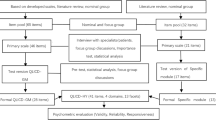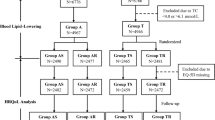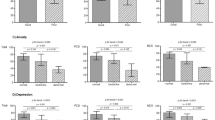Abstract
Objectives: This study compared the prevalence and intensity of symptoms and the health-related quality of life (HQL) of patients taking antihypertensive medications and patients without disease.
Methods: This cross-sectional study used surveys mailed to patient’s homes. All consecutive patients over age 30 years attending either a general medicine or hypertension clinic during 3 months were eligible (n = 437). Hypertension group (HTN-G) patients were diagnosed with primary hypertension, prescribed antihypertensive medications, and had no other symptomatic conditions or drug therapies. Control group (CNTL-G) patients were seen in the general medicine clinic and had no chronic symptomatic conditions or drug therapies. Measures included the Symptom Distress Checklist (SDC, list of 51 symptoms, frequency, and level of distress), the Medical Outcomes Study Short Form-36 (SF-36), medications, blood pressures, and other data obtained from medical records and patient self-report.
Results:A total of 222 patients responded (46% CNTL-G, 55% HTN-G). HTN-G patients were somewhat older (59.0 ± 11.2 vs 48.5 ± 11.7 years, P = 0.001) and had a higher percent of minorities (24.8% vs 13.5%, P = 0.02), but otherwise similar. After adjusting for age and race differences, HTN-G patients reported significantly more symptoms (8.8 ± 7.8 vs 4.7 ± 4.8, P = 0.001) and related distress (32.2 ± 4.2 vs 12.0 ± 18.2, P = 0.001) as well as lower scores (reduced HQL) for most of the SF-36 domains. In general, hypertensive patients had more physical, but not mental symptoms than control patients.
Conclusions: Hypertensive patients receiving antihypertensive medications have more symptoms and lower HQL. Differences were detected by both a brief, general HQL instrument and a detailed, disease-specific instrument. Routine screening of treated hypertensive patients using a brief HQL questionnaire to detect physical symptoms may prove feasible and useful.
This is a preview of subscription content, access via your institution
Access options
Subscribe to this journal
Receive 12 digital issues and online access to articles
$119.00 per year
only $9.92 per issue
Buy this article
- Purchase on Springer Link
- Instant access to full article PDF
Prices may be subject to local taxes which are calculated during checkout
Similar content being viewed by others
References
Kullman S, Svardsudd K Differences in perceived symptoms/quality of life in untreated hypertensive and normotensive men Scand J Prim Health Care 1990 8 (Suppl 1) 47–53
Battersby C et alQuality of life in treated hypertension: a case-control community based study J Hum Hypertens 1995 9 981–986
Puller A, Montoya P, Schandry R, Hartl L Changes in physical symptoms, blood pressure and quality of life over 30 days Behav Res 1994 32 593–603
Schoenberger JA et alSelf-reported side effects from antihypertensive drugs. A clinical trial Am J Hypertens 1990 3 123–132
Siegrist J, Matschinger H, Motz W Untreated hypertensives and their quality of life J Hypertens 1987 5 (Suppl 1) S15–S20
Kjellgren KI et alPerceived symptoms amongst hypertensivepatients in routine clinical practice – a population-based study J Intern Med 1998 244 325–332
Curb JD et alAntihypertensive drug side effects in the Hypertension Detection and Follow-up Program Hypertension 1988 11 (Suppl II) II-51–II-55
Guyatt GH, Feeny DH, Patrick DKL Measuring health-related quality of life Ann Intern Med 1993 118 622–629
Fitzpatrick R et alQuality of life measures in health care: applications and issues in assessment BMJ 1992 305 1074–1077
Weinberger M et alThe relationship between glycemic control and health-related quality of life inpatients with non-insulin dependent diabetes mellitus Med Care 1994 32 1173–1181
Beto JA, Bansal VK Quality of life in treatment of hypertension. A meta-analysis of clinical trials Am J Hypertens 1992 5 125–133
Wilson IR, Cleary PD Linking clinical variables with health-related quality of life. A conceptual model ofpatient outcomes JAMA 1995 273 59–65
Anderson RB, Testa MA Symptom distress checklists as a component of quality of life measurement: comparing prompted reports bypatients and physician with concurrent adverse event reports via the physician Drug Inform J 1994 28 89–114
Anderson RB, Nackley JF, Testa MA Symptom distress check lists as a component of quality of life measurement; comparing symptom reports with responses to multiple choice questionnaires Drug Inform J 1995 29 1689S–1707S
Testa MA, Hollenberg NK, Anderson RB, Williams GH Assessment of quality of life bypatient and spouse during antihypertensive therapy with atenolol and nifedipine gastrointestinal therapeutic system Am J Hypertens 1991 4 363–373
Ware JE, Sherbourne CD The MOS 36-Item Sort-Form Health Survey (SF-36). I. Conceptual framework and item selection Med Care 1992 30 473–483
Aranda P et alUse and adverse reactions of antihypertensive drugs in Spain Blood Pressure 1997 6 (Suppl 1) 11–16
DiTullio M et alPrevalence of symptoms generally attributed to hypertension or its treatment: study on blood pressure in elderly outpatients (SPAA) J Hypertens 1988 6 (Suppl 1) S87–S90
Cooper WD, Glover DR, Hormbrey JM Symptoms in hypertensivepatients: the effect of treatment withdrawal J Hypertens 1988 6 (Suppl 4) S629–S630
Schoenberger JA et alSelf-reported side effects from antihypertensive drugs. A clinical trial Am J Hypertens 1990 3 123–132
Croog SH et alThe effects of antihypertensive therapy on the quality of life N Engl J Med 1986 324 1657–1665
Curb JD et alLong-term surveillance for adverse effects of antihypertensive drugs JAMA 1985 253 3263–3289
Nelson EC et alImpact ofpatient perceptions on compliance with treatment for hypertension Med Care 1978 16 893–906
Hasford J Compliance and the benefit/risk relationship of antihypertensive treatment J Cardiovasc Pharmacol 1992 20 (Suppl 6) S30–S34
Manca G, Lanfranchi A, Cattaneo BM, Grassi G Whenpatients are rendered normotensive Cardiology 1994 85 (Suppl 1) 58–64
Lawrence WF et alHealth status and hypertension: a population-based study J Clin Epidemiol 1996 11 1239–1245
Fryback DG et alThe Beaver Dam Health Outcomes Study; initial catalog of health state quality factors Med Dec Making 1993 13 89–102
Stewart AL et alFunctional status and well-being ofpatients with chronic conditions. Results from the Medical Outcomes Study JAMA 1989 262 907–913
Brook RH et alQuality of medical care assessment using outcomes measure: an overview of the method Med Care 1977 15 (Suppl 9) S1–S165
Bloom JR, Monterossa S Hypertension labeling and sense of well being Am J Public Health 1981 71 1228–1232
Toyoshima H, Takahashi K, Akera T The impact of side effects on hypertension management: a Japanese survey Clin Therapeutics 1997 19 1458–1469
Yodfat Y, Bar-On D, Amir M, Cristal N Quality of life in normotensives compared to hypertensive men treated with isradipine or methyldopa as monotherapy or in combination with captopril: the LOMIR-MCT-IL study J Hum Hypertens 1996 10 117–122
Hansson L, Zanchetti A, for the HOT study group The Hypertension Optimal Treatment (HOT) study: 24-month data on blood pressure and tolerability Blood Press 1997 6 313–317
Sigurdsson JA, Bengtsson C Symptoms and signs in relation to blood pressure and antihypertensive treatment Acta Med Scand 1983 213 183–190
Haynes RB et alIncreased absenteeism from work after detection and labeling of hypertensivepatients N Engl J Med 1978 299 741–744
Acknowledgements
Funding for this project was made available from the Clinical Research Resources Committee Grant administered by the University of Michigan College of Pharmacy.
Author information
Authors and Affiliations
Corresponding author
Appendix 1: Symptom distress checklist factors and component items
Rights and permissions
About this article
Cite this article
Erickson, S., Williams, B. & Gruppen, L. Perceived symptoms and health-related quality of life reported by uncomplicated hypertensive patients compared to normal controls. J Hum Hypertens 15, 539–548 (2001). https://doi.org/10.1038/sj.jhh.1001236
Received:
Revised:
Accepted:
Published:
Issue Date:
DOI: https://doi.org/10.1038/sj.jhh.1001236
Keywords
This article is cited by
-
Cross-cultural adaptation of the Spanish MINICHAL instrument into English for use in the United Kingdom
Health and Quality of Life Outcomes (2022)
-
Fatigue in patients with chronic disease: results from the population-based Lifelines Cohort Study
Scientific Reports (2021)
-
Network-based approach highlighting interplay among anti-hypertensives: target coding-genes: diseases
Scientific Reports (2020)
-
Variations in patient-reported physical health between cardiac and musculoskeletal diseases: systematic review and meta-analysis of population-based studies
Health and Quality of Life Outcomes (2015)
-
Health-related quality of life impact of a triple combination of olmesartan medoxomil, amlodipine besylate and hydrochlorotiazide in subjects with hypertension
Health and Quality of Life Outcomes (2015)



